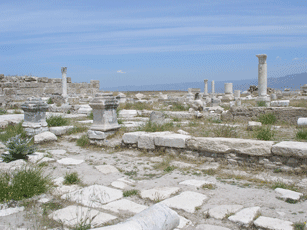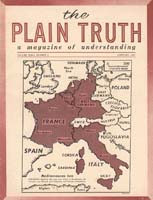
Ancient Laodicea
COGwriter
One of the differences between the Living Church of God (LCG) and the United Church of God (UCG) is how they approach the matter of “church eras” in regards to the churches of Revelation 2 & 3.
In a shot directly against me (titled COGWriter Shows Inconsistency in Church Eras), UCG blogger John Carmack posted the following:
The main problem is how can an “era” come to an end and still have an entire group representing another era left behind? When an empire falls, the empire is smashed. It is gone. Similarly, if the “Philadelphian era” of the church is over, then that church no longer exists.
You know what? According to the usual identification given, Sardis still exists as well. How can that be? In fact, I believe Thyatira is still around. There certainly is a group that seems to fit the description. Again, if eras are true, how could that be?
Now, if John Carmack actually read what I have written about “church eras”, I specifically do state that Sardis, Laodicea, Thyatira, and Philadelphia all exist at the end.
There is no inconsistency that I am aware of in my writings on this as I and LCG (unlike UCG which hedges) teach:
The Living Church of God traces its history from the Apostolic Church in the Book of Acts (the Ephesian era) to the present. The message to the seven Churches in Revelation two and three successively shows the history of the true Church from that time forward. These seven Churches describe succeeding eras, or ages, of God’s Church. We believe that the Philadelphia era began in the 1930s, and that we are a continuation of that Philadelphia era. (Living Church of God, Official Statement of Fundamental Beliefs–Church History)
The Laodicean Church is the last one mentioned in the book of Revelation (Revelation 3:14-22). As the last, it is the one that will be the most dominant at the time of the end. The word “Laodicea” can be rendered “the people rule”, “judgment of the people” or the “people decide.” Laodicea is characterized by a rejection of the governance accepted by the Philadelphians, and by a general lukewarm attitude. Laodicea places emphasis on self (as opposed to proclaiming the Gospel), thus it also waters down the Truth-and so is “rebuked and chastened” and counseled “to buy from Me gold refined in the fire” (Revelation 3:18-19).Because Laodicea is dominant at the end of the age, Philadelphia cannot be predominant then. However, a remnant of Philadelphia must still exist. We know this because Jesus told the Philadelphians: “Because you have kept My command to persevere, I also will keep you from the hour of trial which shall come upon the whole world, to test those who dwell on the earth. Behold, I am coming quickly!” (Revelation 3:10-11). The Philadelphians are the only ones promised protection! The remnant of the Philadelphians are “given two wings of a great eagle, that she might fly into the wilderness to her place, where she is nourished for a time and times and half a time, from the presence of the serpent” (Revelation 12:14). (Thiel B. What is a True Philadelphian? Living Church News, July-August 2001)
In chapters 2 and 3 of Revelation, Christ reveals the characteristics of the seven ages or “eras” of God’s true Church. He finds some fault with most of the seven churches or “eras”—but not Philadelphia. These “eras” represent attitudes that are always present in God’s Church, and they also indicate the progression of “dominant” attitudes in the Church at large. Today, we are clearly in the Laodicean era, which Christ condemns for being “lukewarm” even though it has most of the Truth. The living Jesus Christ said: “I know your works, that you are neither cold nor hot. I could wish you were cold or hot. So then, because you are lukewarm, and neither cold nor hot, I will vomit you out of My mouth” (Revelation 3:15–16).The Living Church of God, which has produced this booklet you are now reading, strives to retain the Philadelphia emphasis even in our Laodicean age. (Meredith RC. Where is God;s True Church Today? LCG booklet, 2005)
LCG teaches that while a certain attitude predominates one era at a time, that some from other “eras” still exist during that time. Essentially, LCG teaches a series of overlapping eras. (John Carmack may wish to consider, for a carnal example, that industrialists existed after the industrial era, etc. The problem is not inconsistency, but the fact that the idea of “eras” includes overlap, and does not preclude individuals who are outside the norm for their time/era.)
This was also the position of the late Herbert W. Armstrong who specifically taught that Sardis (mainly represented by CG7) was around during the time Philadelphia predominated. This was also the position of all the top leaders of UCG prior to them becoming part of UCG (they compromised afterwards).
I am sorry that John Carmack and others in UCG do not understand “church eras”. This is one of the many ways in which I believe they have allowed themselves to go astray and will lead to less correct understanding of end time prophecy as events unfold. Here is some of what it has published on “church eras”:
“You asked if the messages to the seven churches of Revelation 2 and 3 can be applied to eras of church history. As Mr. Herbert Armstrong said in the past, there were seven churches in Asia minor during the life of the apostle John that had certain strengths and weaknesses. Those same strengths and weaknesses could be evident in any church congregation today. Some believe that they also described church eras that began with the apostolic age and until Jesus Christ returns. Since some have disputed this idea, it is a subject that needs more study to see what we can know for sure and what remains in the unknown.” (Internet Correspondence from info@ucg.com to Dr. Thiel. November 13, 1997)
“Since seven represents completeness, these seven lampstands seem to portray a composite picture of the Church of God, the light of the world. Paul explains that the Church is one body (I Corinthians 12:12-13; Ephesians 4:4). However, it has multiple congregations and members scattered throughout the nations. Therefore, these seven specific assemblies of believers appear to effectively represent the totality of the Church. It appears likely that the prophecies of the Church in Revelation 2 and 3 have multiple meanings and applications” (Foster, Roger. God’s Church in Prophecy. Good News, expanded edition. Jul-Aug 2000; p. 8).
“Mr. Walker asked for the Council’s input on this question – how should the Church deal with honest differences in opinion on prophetic topics? Not every issue of prophecy will create this dilemma, he stated, but some will. How do we deal with alternate explanations? Richard Thompson: ‘It could be that the traditional teaching is that we allow three different explanations – for example, the seven churches of Revelation’ ” (Johnson, Doug. United Church of God, an International Association Council of Elders Meeting Report Monday, March 4, 2002 – Cincinnati, Ohio).
From January 2002 through August 2002, UCG ran a series of articles on the 7 Churches of Revelation 2 & 3 written by David Treybig. Unlike anything that WCG ever produced, these articles never say anything about Church eras, do not indicate that the Church was predominant at any particular time, do not mention who or when the Church may have been primarily extant, never mention that Herbert Armstrong was used to raise up the Philadelphia era (or that he left the Sardis era), or anything else suggesting that UCG officially believes in Church eras (which is because officially UCG does not).
Of course there is a reason that UCG does not wish to clearly teach church eras, and that is that they will not like which era that they would have to conclude they are part of.
As far as my writings, several of my articles essentially state, “Revelation 2 & 3 shows a series, in an apparent overlapping succession of Churches of God, each with somewhat different strengths and weaknesses” (The Apostle John and Location of the Early Church: Another Look at Ephesus and Smyrna).
My writings on church eras are not inconsistent and I do consider that John Carmack is unintentionally bearing false witness here. The fact that he does not understand a doctrine that he should have held, but since changed, is sad but consistent with others who have lost the knowledge of proper church governance, priority of gospel proclamation, and other such non-Philadelphia positions.
Those who understand church eras better understand how God has worked through the Church throughout the ages and how He plans to work through it in the future.
Some articles of possibly related interest may include:
Polycarp, Herbert W. Armstrong, and Roderick C. Meredith on Church Government What form of governance did the early church have? Was it hierarchical? Which form of governance would one expect to have in the Philadelphia remnant? The people decide and/or committee forms, odd dictatorships, or the same type that the Philadelphia era itself had?
Unity: Which COG for You? Why so many groups? Why is there lack of unity in the Churches of God? Has it always been this way? What can/should be done about it?
Differences between the Living Church of God and United Church of God This article provides quotes information from the two largest groups which had their origins in WCG as well as commentary.
There are Many COGs: Why Support the Living Church of God? This is an article for those who wish to more easily sort out the different COGs. It really should be a MUST READ for current and former WCG/GCI members or any interested in supporting the faithful church. It also explains a lot of what the COGs are all about.
Old Testament Church Eras Are there seven church eras in the Old Testament? Do they parallel those in Revelation 2 &3?
The Churches of Revelation 2 & 3 from 31 A.D. to present: information on all of the seven churches of Revelation 2 & 3.
1. The Ephesus Church Era was predominant from 31 A.D. to circa 135 A.D. The Church of James, Peter, Paul, and John, etc.
2. The Smyrna Church Era was predominant circa 135 A.D. to circa 450 A.D. The Church led by Polycarp, Melito, Polycrates, etc.
3. The Pergamos Church Era was predominant circa 450 A.D. to circa 1050 A.D. An especially persecuted Church.
4. The Thyatira Church Era was predominant circa 1050 A.D. to circa 1600 A.D. The Church during the Inquisition.
5. The Sardis Church Era was predominant circa 1600 A.D. to circa 1933 A.D. Discusses early history of the Seventh Day Baptists, Seventh-day Adventists, and COG-7th Day.
6. The Philadelphia Church Era was predominant circa 1933 A.D. to 1986 A.D. The old Radio Church of God and old Worldwide Church of God, now basically the Living Church of God.
7. The Laodicean Church Era has been predominant circa 1986 A.D. to present. These are non-Philadelphians who mainly descended from the old WCG.











